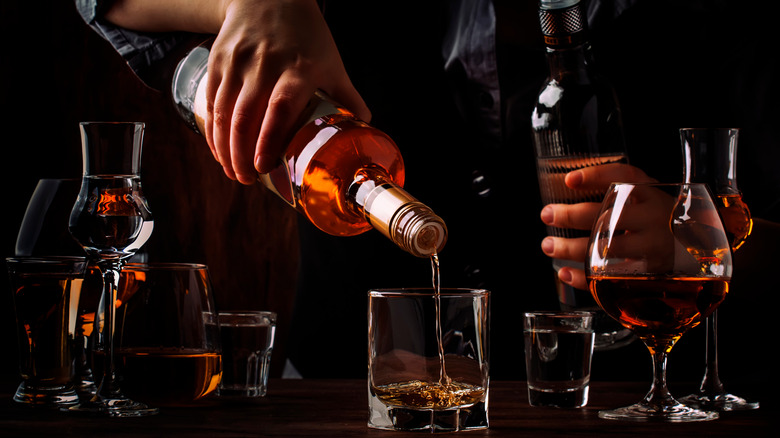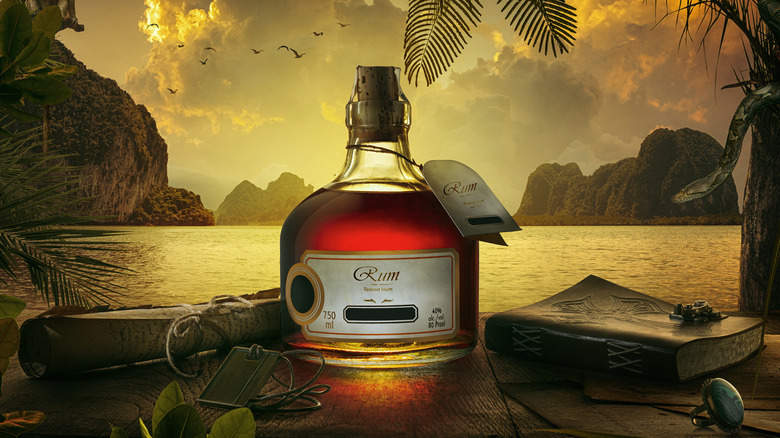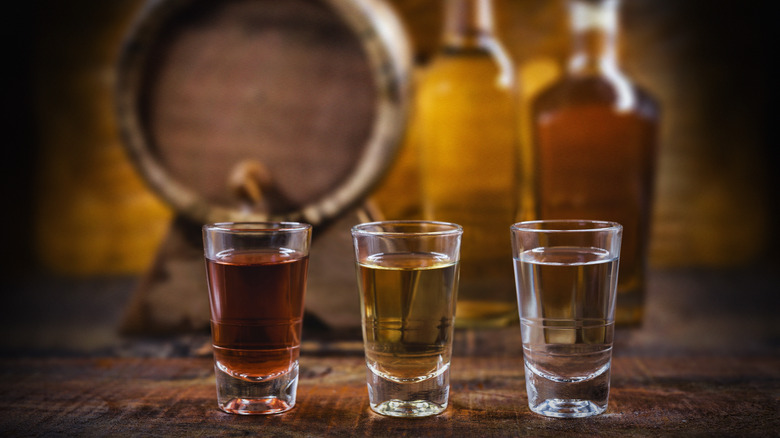Why You Shouldn't Trust The Age Labels On Rum
When it comes to buying booze, one of the most common cues for quality is a bottle's age statement. Initially popularized with the bottled-in-bond movement in pre-Prohibition America as a means of quality control by-product of tax documentation, a bottle's age statement refers to the spirit's time spent aging in a barrel until it's bottled, according to bourbon historian Michael Veach. Aging is a crucial part of curating the depth of flavor of a spirit because the subtle reactions ethanol has with air, water, and oak allow it to mellow, says Veach.
For liquor like bourbon, aging is one of the primary requirements for product designation. To be labeled as bourbon, the spirit must be aged in charred American oak barrels for a minimum of two years and must have an age statement if it's under four years, via New Riff Distilling. Scotch similarly must be aged in oak barrels for a minimum of three years, via Scotch Whiskey Association. Tequila also has a handful of general age indicators, while blanco tequila is unaged, reposado is "rested" in barrels for a minimum of two months, and añejo tequila is barreled for at least a year, according to Difford's Guide. Rum is another primary spirit that also features an age statement, but given the vast diversity of rum, that age statement might not always be the best indicator of quality.
Age isn't everything
Rum can be found all over the world, but it originated in the Caribbean and was popularized in the 1600s in Barbados, via Britannica. With so many different countries producing rum, there are bound to be stylistic differences between countries and producers. Age statements on rum (like bourbon and other spirits) are supposed to indicate the age of the youngest spirit in the blend, but certain blending techniques (like the solera method) obscure a spirit's true age. According to Liquor.com, the solera method separates batches of distillate into different barrels, then continuously adds to the barrels, so by the time a barrel is ready for bottling, it may be a blend of anything between a 20-year-old and two-year-old rum.
Additionally, there are so many other variables that affect a rum's character, that judging solely by an age statement may be a moot point. For one, different countries have different rules and regulations; Puerto Rican spirits must be aged for at least three years to be called rum, and Martinique has designations that reflect French cognac labels (V.S., V.S.O.P., etc.), says Liquor.com. On top of that, simply the location of the aging can drastically impact the rum's flavor given the changes in atmospheric pressure.
Label meanings
During rum's height of popularity, Scotch was lauded as the premium spirit and rum was the libation for the working class, according to Eater. Contrary to bourbon or cognac, rum has no regional designation, no universal age requirements, and just has to be made with sugar cane or sugar cane by-product (molasses). So virtually anyone can make rum, but that means the market for rum is overwhelmingly expansive, and the question becomes "if age statements aren't helpful, how can I tell a quality rum from a mediocre one?"
The best advice a rum aficionado can give to a novice rum enthusiast is to first taste a diverse variety of rum and figure out what you like. There are white (clear) rums, dark rums (usually high-end spirits), gold rums, spiced rums, Rhum Agricole, overproof, and naval strength rums, via Eater. Dark and spiced rum may look similar, but they have drastically different flavors, spiced rum may be a younger spirit that's been infused with botanicals and sweeteners and dark rum is usually barrel aged with full body richness, according to Eater. If a dark rum bottle doesn't have an age statement, look for words like añejo that give a more general indication of age. Also, keep an eye out for words that describe the casking, some rums are aged in sherry casks and another popular trend is to age in repurposed bourbon barrels.


